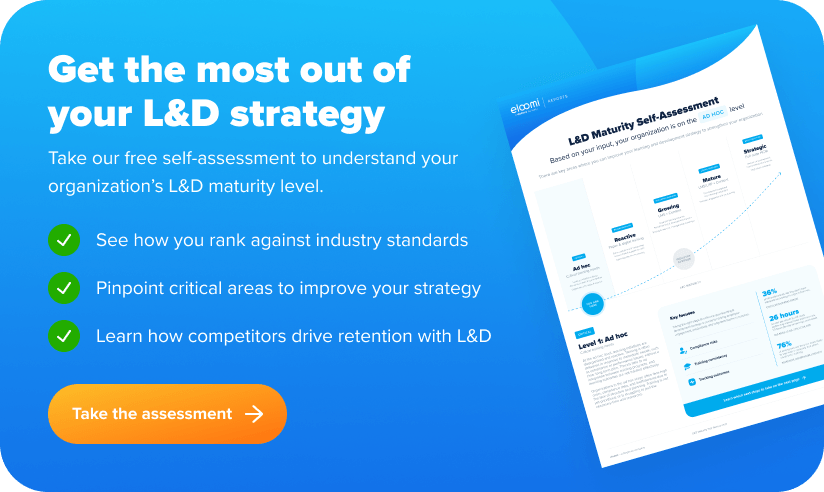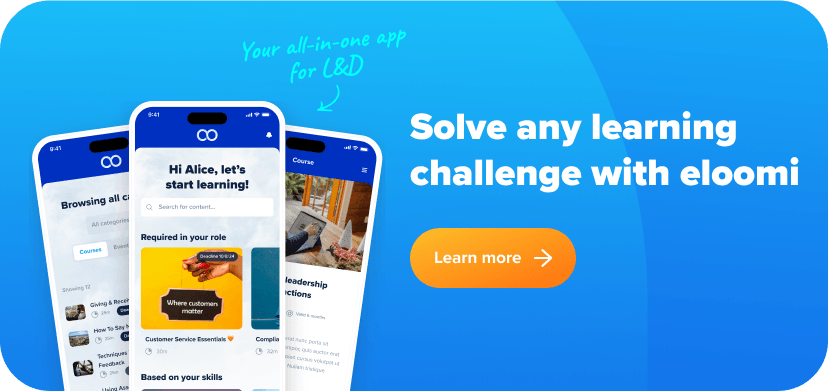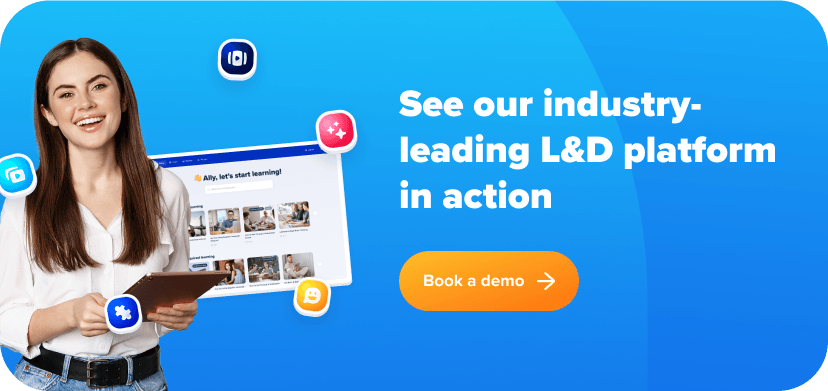Both platforms play a crucial role in delivering an effective learning experience, which is why eloomi offers an integrated approach that combines the strengths of both. To determine the best fit for your business, it’s essential to understand the unique benefits each platform provides and how an integrated solution can enhance learning outcomes.
What is a learning management system (LMS)?
A learning management system is a tool that supports the delivery of education and employee training, making corporate training easily accessible for employees wherever they are, at any time.
An LMS is essentially a digital hub for all types of information related to training and development. It hosts all learning content in a single, intuitive space that’s accessible through user accounts, featuring online assessments, certification capabilities and tracking tools for administrators to measure learning outcomes and ensure learners meet the necessary company standards.
Additionally, an LMS also allows for simple course management, allowing administrators to create, customise, and organise content easily and access detailed reporting.
LMS systems are great tools for streamlining employee onboarding, as they provide essential training materials that help new hires quickly adapt to their roles. Continuous learning and development for employees, compliance training and targeted upskilling and reskilling initiatives, are all benefits of LMS systems that can improve engagement and employee retention.

What is a learning experience platform (LXP)?
An LXP is a platform that offers many of the same capabilities as a learning management system, but with far more focus on the user experience. An LXP empowers learners to follow their own learning paths, also known as employee-led learning, and provides robust tools for admins to build an online learning environment. This includes tools for greater employee communication and collaboration, as well as AI technology that allows employees to curate their learning paths that adapt to individual progress.
Community and collaboration tools, such as discussion forums and community spaces, set LXPs apart from other styles of learning platform as they allow peer-to-peer interaction, fostering a connected and interactive learning experience.
Data-driven insights and user-friendly dashboards enable learners to keep track of their progress, while mobile compatibility supports on-the-go access. Gamification elements like badges and leaderboards are another notable feature of LXPs which help to motivate learners and create an engaging experience.
Does LXP replace LMS?
When considering LXP vs LMS, LXPs don’t replace LMSs; instead, they complement them by working together to create a more comprehensive learning environment. While LMSs are designed for managing formal training and compliance, LXPs focus on personalised, learner-driven experiences and social learning.
When integrated, LXPs and LMSs bring out the strengths of both systems. The LMS handles mandatory training, while the LXP allows for additional, tailored learning and skill development, providing an employee more autonomy over their learning experience which drives higher motivation and retention rates.
By integrating both systems, organisations can offer a balanced learning experience that blends formal, structured training with flexible, self-directed learning. This integration improves access to a diverse range of content, allowing learners to take control of their experience, and enriches data insights for developing better training strategies internally.

LXP vs LMS: Which one should you choose?
If you’re evaluating LXP vs LMS to decide which one to adopt for your business, it’s essential to conduct a comparative analysis based on alignment with your organisational needs. The choice is dependent on the training and development goals your business wants to achieve.
The difference in features:
| LXP | LMS |
| A personalised learning journey based on user preferences and history. | Structured courses and training programs that are assigned by administrators. |
| Users can curate their own learning content from various sources. | Compliance tracking, completion rates, and certificate management. |
| Social learning through peer-to-peer interaction is encouraged. | Robust assessment features. |
| Microlearning experiences can be accessed on-demand | An administrative interface that can limit employee access to content. |
| Modern interface that allows users to freely access content. |
Pros and cons of each platform
| LXP Pros | LXP Cons |
| Enhanced learner engagement through personalised content and social features. | Potential information overload due to the vast amount of available content. |
| Flexibility in accessing diverse learning materials at any time. | Reliance on algorithms for content recommendations may lead to irrelevant suggestions if improperly managed. |
| Encourages a culture of continuous learning and knowledge sharing. |
| LMS Pros | LMS Cons |
| Structured approach ensures all employees receive essential training. | Limited personalization can lead to disengagement among learners. |
| Strong tracking capabilities for compliance and performance management. | Often viewed as a top-down approach that does not cater to modern learners’ needs for flexibility. |
| Familiarity in many organisations makes implementation straightforward. |
Organizations focused on compliance and structured training may prefer an LMS, while those aiming for skill development and employee engagement might choose an LXP.
Consider the needs within your organization. If your organization is growing, or has a focus on employee retention, offering tailored learning and development opportunities is paramount. For smaller companies with traditional training environments requiring oversight and competencies in particular areas, an LMS may be preferable. It’s also important to consider how the chosen platform aligns with long-term organisational goals related to workforce development, adaptability to change, and technological advancements.
How eloomi integrates LMS and LXP features
Our solution offers a comprehensive all-in-one learning and development platform that integrates the best features of both LMSs and LXPs. This integration allows organisations to streamline their training processes while enhancing user engagement.
With eloomi, companies can manage formal training programs alongside personalised learning experiences, making it easier to develop and retain talent. The platform supports various learning formats, from structured courses to skills-based course recommendations, ensuring that all employee development needs are met efficiently.
By combining the strengths of both LMS and LXP systems, eloomi provides a robust solution that addresses the limitations of traditional learning platforms. The platform features a user-friendly interface that simplifies course creation and management while also offering advanced analytics for tracking learner progress and engagement. Additionally, eloomi is expanding to include AI capabilities that facilitate automatic course creation and smart quiz generation, aiming to enhance the learning experience by providing tailored content recommendations. This seamless integration fosters a culture of continuous learning, where employees can access a wide range of resources that cater to their individual needs and preferences.
Using an integrated platform like eloomi offers numerous benefits for organisations with diverse learning needs. It allows for greater flexibility in training delivery, enabling employees to learn at their own pace and on their own terms. The combination of social learning features, such as community engagement and peer feedback, enhances collaboration among learners.
eloomi’s ability to integrate with existing HR systems also ensures that all employee data is consolidated in one place, streamlining administrative tasks and improving overall efficiency. Ultimately, eloomi empowers organisations to create impactful learning experiences that drive employee growth and business success.
Real-world applications of LMS and LXP
Method Putkisto, a Finnish fitness, health, and wellness brand, is known for its unique method of deep body stretching and face exercise training, founded by Marja Putkisto. When the pandemic made in-person training difficult, they needed to adapt quickly. To modernize their outdated email and intranet-based learning, Method Putkisto turned to eloomi to build a scalable, digital training solution for their global team of instructors.
Within just five months, they launched a hybrid learning platform with eloomi, creating interactive courses designed to train instructors in leading guided meditation and wellness practices. This new system transformed their instructor training by enabling the delivery of rich multimedia content, including video and audio meditation practices, which provided instructors with fully immersive learning experiences.
Pain Points: Method Putkisto struggled with outdated, manual processes and lacked a digital training platform to scale their instructor training globally.
Solutions with LMS: Using eloomi, Method Putkisto created a comprehensive hybrid training platform that integrates guided meditation courses, complete with audio and video content for a truly immersive learning experience.
Key Results: Method Putkisto now enjoys flexible, efficient, and scalable instructor training, offering a consistent learning experience across their global network, from Europe to Asia.
By utilizing eloomi’s LMS, Method Putkisto was able to deliver engaging, multimedia-rich courses that go beyond traditional training. Instructors can now access guided meditation lessons online, immersing themselves in the learning experience while developing the skills they need to lead their own classes. This unique approach not only enhanced the quality of training but also enabled the brand to expand globally with confidence. The full customer story is available to read here.

The new approach to LXP vs LMS
The LXP vs LMS discussion reveals that both systems serve different purposes in corporate training. LMSs focus on structured, top-down learning, which allows stronger administrator control over learning content and mandatory training activities where employees progress is tracked through assessments. LXPs, on the other hand, offer a more personalised and learner-driven approach, allowing users to curate their own content using a variety of resources based on their interests and goals, which can play a hand in improving engagement.
eloomi unifies these two approaches, combining the structured learning paths of an LMS with the flexibility and personalization of an LXP. By offering both formal training and self-directed learning in one platform, organisations can meet essential training requirements while promoting continuous employee development. This integrated solution also provides a comprehensive view of learning progress across all channels and effectively tracks performance outcomes.





